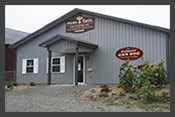- demolyneaux@stny.rr.com
- 607-349-8794
Dave's Gun Dog Training Articles
Curing the Wagging Tail, "Flagging" by Dave Molyneaux
 When a pointing dog scents a bird and locks up with intense rigidness, the picture is nearly breath taking. As the pups eyes are rotated off to the side indicating the direction of the hidden quarry, the remainder of its body emulates a monument.
When a pointing dog scents a bird and locks up with intense rigidness, the picture is nearly breath taking. As the pups eyes are rotated off to the side indicating the direction of the hidden quarry, the remainder of its body emulates a monument.
Some dogs when on point, have a tail that moves and rotates like a vibrator. This action is not desirable when hunting with another dog at the same time. Reason being, obtaining a disciplined honor is very unlikely. The honoring dog does not notice and disregards most pointing dogs that are not motionless. A dog that mistakenly does not stop and honor will cause tensions between the two dogs creating competition. Formally speaking, hunting etiquette has been violated.
Flagging is a case where the pointing dog is expressing anticipation of a future bird contact. If this dog could talk, it would be saying over and over again, “I’m going to get it, going to get it, going….”. The cure is to teach your dog, with a no bird reward, unless the tail ceases its movement.
This is how we instruct our clients to actually train their dog to stop the tail movement. It all begins when a pup finds a bird and goes on point. The handlers approach is critical and complete focus should be on reading your pup.
Begin your advance toward the dog broad side as if you’re moving in to flush the bird. It is important you want him to be able to track your movement using his peripheral vision. As you are walking in slowly you notice a flagging tail. Immediately stop and say “no”, in a low tone, moderate voice. Stand there until the tail ceases movement. Continue to not move for another 30 seconds or so. Again, begin your advance toward Fido and he will most likely begin to flag again anticipating you walking in to flush the bird as done in the past. As you notice the tail movement beginning once again, stop say “no”, and slowly walk backwards to your previous point, and stop. Again pause for several seconds after the tail stops. A word of caution here, do not make the pup dwell for an extended period of time, for this will cause worrying and shut down. It may take more than one bird contact to begin to see a respectable degree of results. Dogs learn best by repetition. Each time you exercise this format of stop and pause, and he ceases tail movement, extend the time duration. I short order all you have got to do is slow down your approach and all tail movement quits. Dogs need and work favorably when given hands on praise. It relives a lot of a nervous tension that the pup experiences when you are standing motionless. For this reason before you actually walk up to flush the bird, spend a few moments by placing your hand under the dock of the tail, and pump and steady it with the palm of your hand.













